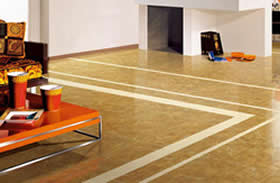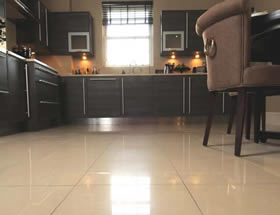Difference between Vitrified Tiles and Porcelain Tiles
Key Difference: Vitrified tiles refer to the tiles that are made by the process of vitrification. In this process, high temperatures are used for baking the tiles. Porcelain tiles are also vitrified tiles and generally fall in the category of full vitrified tiles. It means that a porcelain tile has the water absorption of less than 0.5 percent.
Thinking about replacing your tiles? Then you might hear various names in the tiles industry and you might get confuse. Two such terms are vitrified and porcelain. Sometimes you may also hear vitrified porcelain. This article can help you in making the necessary distinction.
 Vitrified tiles have got the name from the word 'vitrify' referring to the process of making a glass or similar to a glass. All the tiles that are made using the method of vitrification fall in the category of vitrified tiles. This tile is known for its capacity to absorb less water and also for being stain resistant. Vitrified tiles are composed of a mixture containing silica and clay. This mixture is used to form a non-porous tile that has a glassy texture.
Vitrified tiles have got the name from the word 'vitrify' referring to the process of making a glass or similar to a glass. All the tiles that are made using the method of vitrification fall in the category of vitrified tiles. This tile is known for its capacity to absorb less water and also for being stain resistant. Vitrified tiles are composed of a mixture containing silica and clay. This mixture is used to form a non-porous tile that has a glassy texture.
Porcelain tiles fall in the category of vitrified tiles and therefore, they are also sometimes referred to as only vitrified tiles. These tiles are fully vitrified, glazed or unglazed and are generally made from a mixture of clays and feldspars. They are shaped by pressing a powdered body. These tiles have water absorption less than 0.5% (ISO 10545-3). Specific characteristics of these tiles are:
1. High mechanical strength
2. Frost resistance
3. Good abrasion resistance.
Porcelain tiles are also considered as a from of ceramic tiles as these tiles also use a mixture  of fine grain clays and other minerals. However, a porcelain tile can be differentiated from other ceramic tiles on the basis of its dense body and also the use of a very high temperature for the firing. These tiles are made by the dust pressed method. Thus, the tiles are denser and more durable than other ceramic tiles.
of fine grain clays and other minerals. However, a porcelain tile can be differentiated from other ceramic tiles on the basis of its dense body and also the use of a very high temperature for the firing. These tiles are made by the dust pressed method. Thus, the tiles are denser and more durable than other ceramic tiles.
These tiles are grained finished. A true porcelain tile has the same color throughout its body. If the tile chips, then also it become less noticeable as same color is observed underneath the chipped surface.
It comes in two important forms- glazed and non-glazed.
- Glazed porcelain: - it has filled up holes that are microscopic.
- Unglazed porcelain: - unglazed tiles remain in its natural form with no added glaze. Unglazed is preferred for its durability over the non glazed ones. Glazed possess better looks than the unglazed ones and thus, are preferred for shops etc.
In addition to these categories, a porcelain tile can be of polished or semi-polished type. An elaborate technique is used to provide the finish to these tiles.
Due to the benefits of these tiles over other ceramic tiles, porcelain tiles usually cost approximately 10% more than the regular non porcelain ceramic tiles.
These tiles are more resistant to moisture and therefore, they are generally used in the bathrooms or laundry rooms. It comes with the added advantage of durability. Setting of these tiles can be a difficult task. The tiles are very hard and strong and thus, require a lot of effort to cut into the desirable shapes.
Thus, we can easily differentiate between the two. Vitrified tiles refer to the tiles that employ the vitrification process in making, whereas a porcelain tile is a type of fully vitrified tile and thus, specifically has water absorption of less than 0.5 percent.
Image Courtesy: trade.indiamart.com, naturepop.com









Add new comment